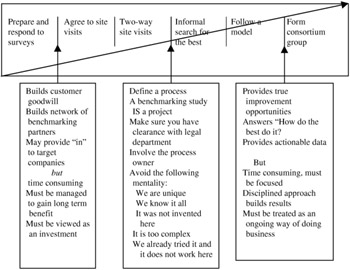GENERAL INTRODUCTION TO BENCHMARKING
A BRIEF HISTORY OF BENCHMARKING
The term "benchmarking" was coined by Xerox in 1979. Xerox has now performed over 400 benchmark studies, and the process is totally integrated at all levels as part of the business planning process. The approach has actually been in use for a number of years ” although it was often called by different names . (Reverse engineering is an approach used to study the design and manufacturing characteristics of competitive products. Benchmarking of computer hardware and software is a very common practice.)
Benchmarking extends the concept to consider administrative and all management processes. There is a conscious attempt to compare with the "best of the best" even ” especially ” if that is not a direct competitor.
The fundamental process in starting benchmarking is to think about the area to be benchmarked, which can be just about anything, and ask yourself, "Who is especially good at that? What can I creatively imitate?" A typical process for doing a benchmarking is shown in Figure 3.1.

Figure 3.1: The benchmarking continuum process.
POTENTIAL AREAS OF APPLICATION OF BENCHMARKING
Benchmarking is a methodology that can be used along with other systematic, comprehensive management approaches to improve performance. It is not an end unto itself. Some examples of applications of benchmarking include:
-
Broad management focus
-
Cost reduction
-
Profit improvement
-
Business strategy development
-
Total quality management
-
-
Individual management processes
-
Improving customer service
-
Reducing product development time
-
Market planning
-
Product distribution
-
-
Highly specific focus
-
Invoice design
-
Sales force compensation
-
Fork lift truck maintenance
-
The critical questions to ask are:
-
What are the areas that potentially could be benchmarked?
-
How do you prioritize and focus the efforts?
EAN: 2147483647
Pages: 235